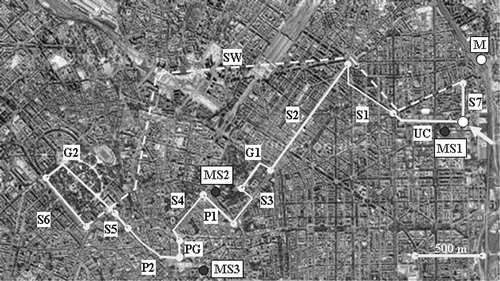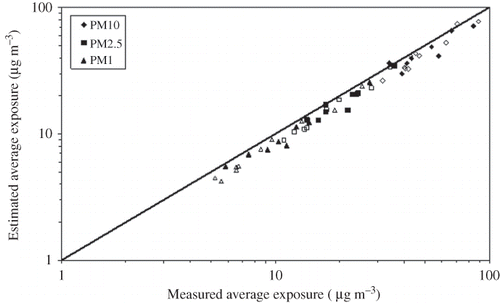ABSTRACT
Measurement campaigns for airborne particles along a pedestrian route in the city center of Milan were performed by means of a portable instrument consisting of an optical particle counter and a global positioning system (GPS) signal receiver. Based on the size-resolved particle number concentration data and on proper density factors experimentally determined for Milan urban area, the mass concentrations were calculated in terms of particulate matter with aerodynamic diameters ≤10 μm (PM10), ≤2.5 μm (PM2.5), and ≤1 μm (PM1). Besides directly measuring the personal exposure to PM throughout the route, the measurement campaigns pointed out small spatial and temporal variations of the concentration ranges in the different urban microenvironments visited along the route as well as very peculiar features of the particles levels in the underground subway. These findings suggested that the personal exposure of pedestrians in the city center could be estimated by simply taking into account the exposure at the open air and in the subway. The comparison between measured and calculated exposures according to the microenvironment-based estimation results in reasonable accordance, even though the estimations tend to slightly underestimate (12%) the actual measured exposure.
This work demonstrates that the actual exposure of pedestrians in Milan city center can be estimated by exposure modeling based on ambient data from an urban background site, provided that high-time-resolution data are available. This suggests that instruments such as the optical particle counters (OPCs) should be also included in the air quality monitoring network, together with conventional monitors used for air quality standard verification, in order to allow personal exposure assessment at open-air urban sites. However, because OPCs provide indirect information on the particle mass concentration, local field tests are required for establishing the proper algorithm to obtain mass concentrations from particle counting.
INTRODUCTION
Epidemiological associations have been observed between ambient concentrations of particulate matter (PM) and morbidity and mortalityCitation1 and recent toxicological studies have demonstrated that airborne PM in urban areas has a clear correlation with the respiratory and cardiovascular diseases as a consequence of increased oxidative stress and inflammation.Citation1,Citation2 Health impact assessment of atmospheric pollutants is based on the actual exposure to harmful pollutants and recent regulations, such as the European Union Directive 2008/50/EC, include exposure indicators and exposure reduction targets together with concentration-based air quality limits for PM.Citation3
Exposure defines the interaction between the environment and a living subject and can be either directly measured or estimated by applying models.Citation4 In air pollution exposure studies, personal exposure determination by direct measurements requires the individuals of the study population to carry sampling equipments, whereas exposure modeling requires a validated model and sufficient, representative, good-quality input data, providing information on the magnitude of the pollutant concentration in the exposure environments, as well as on the duration and the time pattern of the exposure.Citation5 Once these requirements are fulfilled, a model can be repeated for a large number of individuals or populations. Among the models proposed for the air pollution exposure assessment, the microenvironment approach has been commonly used to model exposure.Citation6,Citation7 The concept of microenvironment (ME) as an area where the air pollutant concentrations can be assumed constant and spatially homogeneous was created in order to help the exposure assessment. Originally applied to indoor air, the concept of ME may be similarly applied to outdoor locations exhibiting comparable concentration levels. Although in reference literature the exposure is often defined as “total exposure”,Citation5 the “time-weighted average exposure”Citation8 better expresses the fact that the exposure is the sum of the weighted concentrations to which people are exposed in the MEs they visit. A key point for the ME approach is the proper evaluation of the ME-related concentrations Ci which for outdoor MEs can be derived from direct exposure measurements and ambient concentration data,Citation9 or estimated by means of atmospheric dispersion modeling.Citation10 However, when the estimation is performed for relatively short periods of time, the ME-related concentration Ci can hardly be evaluated from fixed air quality monitoring station data with the typical 1-hr time resolution, which may not represent the large variability in the actual concentration of the target pollutant both in time and space (i.e., in the various MEs). Moreover, the dependence of the exposure on the location and activity of the exposed subject further suggests to address the evaluation on specific age- (e.g., adults, children) and activity-based (e.g., taxi drivers, office workers) population categories or on groups of people sharing the same transportation mode (e.g., pedestrians, cyclists, train commuters).Citation11,Citation12
This work is focused on the assessment of the pedestrian exposure to particulate matter in the city of Milan located in the river Po valley in northern Italy, where many cities are facing serious problems in complying with the European Union PM10 air quality standards.Citation3 Although several works for the urban area of Milan have been recently published concerning PM concentration levels,Citation13,Citation14 PM chemical composition and spatial distribution,Citation15,Citation16 and particle number concentration and size distribution,Citation17–19 only a few studies are primarily concerned to the assessment of the exposure to fine PMCitation20,Citation21 and none of them specifically addressed the pedestrian exposure.
Direct measurements of the personal exposure have been performed along a pedestrian route in the city center by means of a portable instrument equipped with an optical particle counter and a global positioning system (GPS). The location of the instrument and the PM concentration data have been recorded with 1-min time resolution, thus enabling a detailed evaluation of the spatial distribution of size-resolved PM concentration data. The potential for the application of ME-based exposure modeling based both on direct measurement-based estimates of the ME-related PM concentration and on data collected at an urban background station of the air quality monitoring network to assess the pedestrian exposure in Milan city center is evaluated.
MATERIALS AND METHODS
Instruments
Pedestrian exposure to fine particles was evaluated through measurement campaigns performed by means of a portable apparatus consisting of a backpack containing an aerosol monitor and a GPS receiver. Particle number concentrations for seven size bins in the 0.3–10 μm size range (0.3–0.5, 0.5–0.7, 0.7–1.0, 1.0–2.0, 2.0–3.0, 3.0–5.0, 5.0–10 μm) were measured at 1-min time resolution by means of an optical particle counter (OPC) with laser light-scattering technology (PersonalDustMonit; ConTec EngineeringCitation22, Milan, Italy) and georeferenced through the concurrent GPS signals. Ambient air is drawn into the measurement cell at a rate of 1 liter per minute by means of a straight sampling tube (7 mm internal diameter, 40 cm length) with the inlet located in the breathing zone. Due to the straight configuration of the sampling line, no significant particle losses are expected in the sampling tubing. Similar monitors have been used in PM exposure studies reported in literature.Citation23,Citation24
Size classified PM mass concentrations C mass (μg m−3) were separately calculated for each of the seven size bins from number concentration data C number (particle per liter) by means of corresponding size-resolved conversion factors ρ i (g cm−3) and under the assumption of spherical shape of the particles according to the following formulation:
The conversion factors ρ i , actually the product of particle density times a shape factor for nonsphericity, used to convert number concentrations to mass concentrations are reported in for the seven size bins of the OPC. These factors had been previously estimated for Milan area by multiple linear regression technique based on 24-hr concentration data from collocated parallel field tests of the OPC instrument and PM10 and PM2.5 gravimetric measurements at an urban background site in Milan. The gravimetric measurements were performed daily by means of low-volume samplers equipped with PM size-selective inlets according to the current European standard methodsCitation25,Citation26 for PM2.5 (EN19047:2005) and for PM10 (EN12341:2001).
Table 1. Size-resolved conversion factors ρ i (g cm− 3) used in Equationeq. 1.
During the campaigns, concurrent measurements were performed by means of an identical OPC instrument at an urban background site in Milan (MS1 site in ) in order to compare these measurements with those obtained en route with the portable instrument. Prior to the campaigns, collocated parallel measurements at this site showed the comparability of data from the two OPCs. Furthermore, the capability of the OPCs to correctly represent the PM10 and PM2.5 mass concentration was also assessed by comparing their results with data from the regional air quality monitoring network (daily average concentrations from Beta (Opsis, Sweden) attenuation monitors) during simultaneous measurements at both urban background and urban traffic sites in Milan.
Monitoring Campaigns
The measurement campaigns were conducted by an operator wearing the backpack carrying the portable instrument, walking along a pedestrian route () from the University campus to the city center of Milan and back for a total travel time of about 3 hr. For data analysis purpose, the route was subdivided into 13 open-air sectors individuated based on the homogeneity with respect to the street features and the local traffic intensity, which constitute the main parameters influencing the primary particle levels in the urban area; the route also included a trip on the urban subway (approximately 20 min), which constitutes the only non-open-air sector. reports the main characteristics of the sector as far as the traffic flow conditions are concerned (i.e., number of carriageways and lanes, kind of pavement, presence of streetcar tracks). Traffic flows were in the orders of 1.5–2 thousand vehicles per hour in sectors S1 and S2 and in the orders of a few hundred vehicles per hour in all the other open-air sectors. Part of the monitoring route was in the very city center area, within a low-emission zone where an entrance fee is due, according to the engine (gasoline or diesel fuelled) and the age of the vehicle. This system of traffic restriction resulted in a 30% reduction of the total number of vehicles entering the city center, but still with a traffic flow in the order of 3–4 hundred vehicles per hour.
Table 2. Pedestrian route sector descriptions
The route was performed on 10 working days throughout the month of May 2009, in the late morning hours (9 a.m. to 12 a.m.) and repeated in the early afternoon (1.30 p.m. to 4.30 p.m.) of each measurement day; additionally, the route was also repeated on one Sunday afternoon when the traffic circulation ban in the city center limited the entrance to sectors S2 and S3 of all the vehicles.
During the monitoring days neither critical atmospheric pollution episodes nor particular meteorological conditions occurred, except for the alternation of rainy and dry periods normally characterizing the climate during May in Milan area. Consequently, PM concentration levels monitored were in the typical range for the period, with the lowest daily average levels on heavy rain days (). The morning and afternoon general meteorological conditions did not change significantly, except for the mixing layer height: according to its typical daytime pattern for May in Milan, the mixing layer height progressively rises from 200 up to 500 m throughout the morning and keeps on rising during the early afternoon, ranging between 800 and 1000 m throughout the afternoon. As a consequence of the higher convective turbulence in the lower atmosphere, the ground-level wind speed is slightly stronger in the afternoon, but still in the 1–2 m s−1 range. Wind direction was rather variable during the monitoring period but due to the low wind speed, the concentration levels at the leeward and windward side of the streets were not significantly different.
Table 3. Air quality and meteorological conditions on measurement days
Data Processing and Statistical Analyses
The route patterns of the 1-min measured PM concentrations are examined for each 3-hr sampling period, in order to localize the short-duration events (e.g., streetcar passage on the tracks), which may result in a momentary peak in the concentration capable of influencing the sector-resolved average values.
The main statistical parameters (mean, median, maximum, minimum, interquartile range [IQR]) related to 1-min concentration data are reported with box-plots for the main PM fractions (PM10, PM2.5, PM1) separately for the morning and afternoon periods.
Analysis of variance (ANOVA) tests and principal component analysis are performed on the sector-resolved PM concentration data in order to investigate the influence of the sector features, of the time of the day, and of the meteorological parameters, namely the rain precipitation, on the observed concentrations, and to group the route sectors into representative microenvironments.
Exposure Assessment
The pedestrian exposure (E) on a generic route in the city center is, by definition, the average concentration directly measured walking the route. However, the exposure may also be estimated with the ME approach using the following equation and calculating the exposure as the sum of the partial exposures across the visited MEsCitation8:
The potential application of the ME approach, based on ME-related concentrations estimated from the sector-resolved concentrations data and according to the grouping criteria suggested by the statistical analyses, is evaluated for estimating the pedestrian exposure to PM10, PM2.5, and PM1. Furthermore, the actual pedestrian exposure measured with the portable OPC is compared to the exposure calculated based on OPC data recorded at the urban background site MS1.
RESULTS AND DISCUSSION
PM Mass Concentration
The analysis of the route patterns for each measurement period shows concentration trends that keep more or less the same level throughout the whole route, with the only exception for the subway sector (SW). However, the occasional concentration peaks caused by particular local events such as the streetcar movement on the tracks (sector S4), or the vehicle transit at both high-traffic streets (sector S2) and low-emission zones (sector S3), are also detectable ().
Figure 2. Time pattern of PM10 (solid line), PM2.5 (dashed line), and PM1 (thick line) concentration (μg m−3) measured during the afternoon route on May 19, 2010.
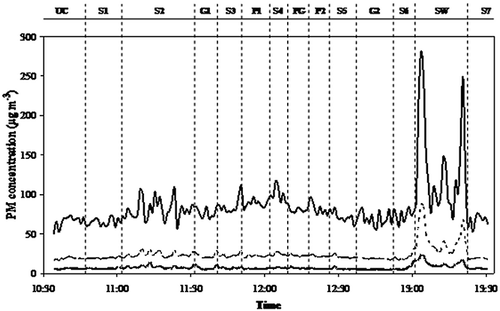
These events result in a rather high intrasector (i.e., within the sector) variability of the 1-min concentration data, as shown in where the descriptive statistics of the sector-resolved PM10, PM2.5, and PM1 mass concentrations are presented. In particular, the largest intrasector variability was registered at the SW sector for both PM2.5 and PM10, with peak values in the order of 100 and 250 μg m−3, respectively. Literature studies report fluctuations in the particle number and mass concentration in subway cars, both observed during tunnel travellingCitation27 and during stops at station platforms.Citation23 In the present work, no evidence was found in order to associate the concentration peaks to a particular journey phase, essentially for the very short time between the train stops.
Figure 3. Sector-resolved box-plots for the distributions of 1-min PM10 concentrations (μg m−3) measured during the morning and afternoon routes.
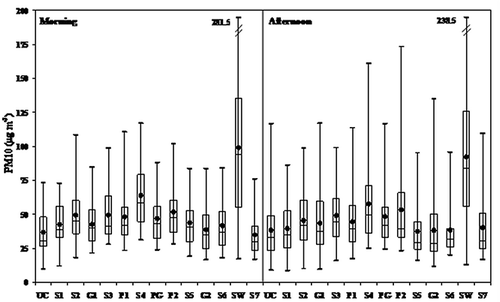
Figure 4. Sector-resolved box-plots for the distributions of 1-min PM2.5 concentrations (μg m−3) measured during the morning and afternoon routes.
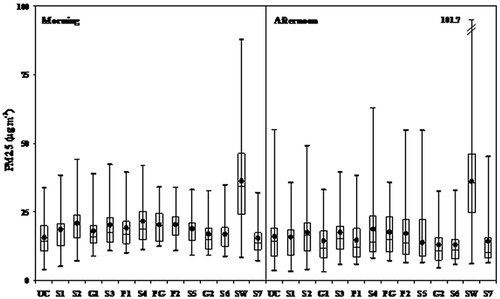
Figure 5. Sector-resolved box-plots for the distributions of 1-min PM1 concentrations (μg m−3) measured during the morning and afternoon routes.
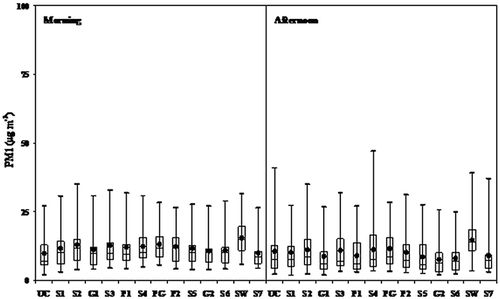
Despite their different characteristics, the open-air sectors show as a whole similar average concentrations, with the highest levels measured in the restricted circulation area with the stone-paved road and exposed to streetcar emissions (sector S4), and the lowest in the green area close to the city center (G2).
Sector S4 has very peculiar features common to the most part of the main streets in the low-emission zone in Milan city center: even though with restrictions, vehicular traffic is present, the street is stone-paved and there are streetcar tracks for the urban streetcar transportation service. Furthermore, the street is rather narrow (only two lanes and small sidewalks aside, for a total width of about 10–12 m, compared to about 20–25 m for the high-traffic roads) with 4–5-story buildings on both sides. All these factors tend to reduce dispersion, thus partially offsetting the lower local emissions from traffic, with resulting concentration levels of the same order of even greater than at the high-traffic sectors S1 and S2.
For all the size cuts, the average concentrations at the SW sector are always higher than at the open-air sectors, with a more pronounced increase for PM2.5 and PM10. ANOVA tests at α = 0.05 significance level result in a the statistical equivalence of the sector-related average PM10 and PM2.5 concentrations, except for the SW sector, for both the morning and afternoon routes; conversely, they do not show any statistical difference, even for the SW sector, for PM1 concentration, whose level is less variable throughout the whole route. These results are consistent with the lack of statistical difference in PM10, PM2.5, and PM1 concentration levels at different traffic intensity zones in Milan reported by Invernizzi et al.Citation28
The comparison of morning and afternoon route data shows higher concentration levels in the morning at all the sectors but without any statistically significant difference. Conversely, the comparison between data collected on rainy and dry days shows significantly lower concentrations (30–40% less) at the open-air sectors for all the size cuts. However, the clearing out effect of the rain is more efficient at low-emission zones and, above all, at the two green area sectors due to the limited PM resuspension from the unpaved walkways; conversely, at high-trafficked sectors, the effect of the rain is partially offset by the local emission of traffic.
Finally, the comparison between the afternoon route data collected on working days and those of the Sunday's afternoon shows a huge decrease in the concentration levels: at the open-air sites the average relative reductions are 42% for PM10, 46% for PM2.5, and 48% for PM1, with the highest reductions observed at high-trafficked sectors (average for sectors S2, S3, and S4 only: 47%, 50%, and 52%, respectively) and the lowest (about 40% for all three size cuts) in the pedestrian area in the city center (sectors PG and P2).
Size Distributions
The sector average PM mass size distributions, shown in for the SW and two open-air sectors, display a bimodal shape. At the open-air sectors, the overall mass is mainly associated to the finest size fraction (0.3–0.5 μm) and to the particles in the coarse size range (2.5–10 μm), in agreement with the typical bimodal aerosol volume size distribution reported for urban areas.Citation29 At the SW sector, the distribution displays a main flat mode in the coarse particle size range (2–10 μm), by far prevailing over the smaller mode located around 0.6 μm. Such different shape of the distribution suggests that PM concentration levels at the SW sector are the result of locally emitted particles having diameters larger than about 1 μm and of those drawn from the outdoor into the underground environment by the ventilation systems.Citation30 Possible sources of particulate matter in the underground are reported in literature to be related to the operation of trains, not only by wear of wheels, rails, brakes, conductor rails, and voltage lines, but also by resuspension of dust from the embankment due to train and passenger movements.Citation23,Citation31–33 This suggestion is confirmed, in the present work, by the fact that the high-peak pattern observed in the SW sector is mainly associated with the increase of fine supermicron (PM1–PM2.5) and coarse particles, typically generated by mechanical wear.
Figure 6. Sector averaged mass distribution (thin lines, white symbols: morning route; thick lines, black symbols: afternoon route) for sectors G2, S2, and SW.

Furthermore, this evidence on the very peculiar source of particles also suggests that the mass concentration data for PM2.5 and PM10 derived from the OPC data likely underestimated the actual PM concentration in the subway. In fact, the size-resolved density factors used to convert particle number to mass concentration have been derived through ambient air monitoring whereas a specific set of density factors for the subway microenvironment would provide a better assessment of the concentration levels in this environment.
Exposure Assessment
The measured exposure data, expressed as the average concentration for the 3-hr route, are summarized in the box-plots of For both the morning and afternoon routes, the mean exposure values are in the orders of 50, 20, and 10 μg m−3 for PM10, PM2.5, and PM1, respectively. Coherently with the general air quality conditions, the highest exposures have been observed on the most polluted dry days and the lowest on rainy days with heavy showers; Sunday afternoon data are close to the lowest observed exposures. These measured exposures have been compared with the exposures estimated by the ME approach. Principal component analysis applied to sector-resolved PM mass size distributions data confirmed the findings of the previous statistical analyses about the presence of only two different MEs (the open-air sectors and the subway) within the route. Furthermore, the factor loadings plots () clearly point out the small daily intersector variability for the open-air sectors (i.e., the open-air daily data tend to aggregate into small clusters) and the role of the daily meteorological conditions (i.e., the daily clusters are well separated, especially for the dry days). This evidence suggested that the exposure could be estimated based on the OPC data measured at the urban background site MS1 concurrently with the route measurements.
Figure 7. Size-resolved box-plots for the distributions of the route-averaged exposures (μg m−3) measured during the morning and afternoon routes. (Diamonds: the Sunday's afternoon route.)
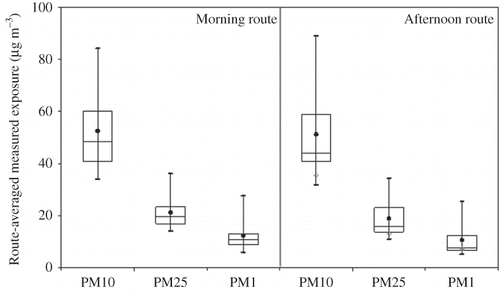
Figure 8. Representation of the sectors on the factorial plane in the morning (upper panel) and in the afternoon (lower panel). Variable considered: particle number size distribution. (Circled data points represent SW sector; grey symbols represent the rainy days.)
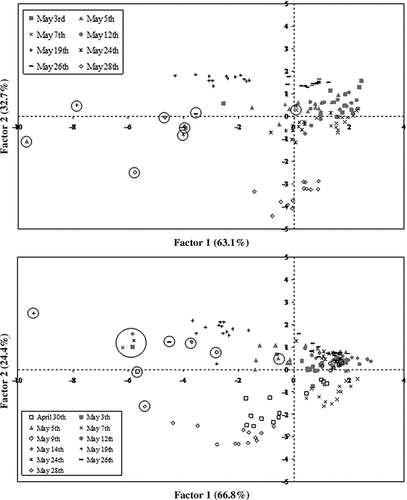
The open-air average concentration levels for PM10 vary roughly by a factor of 2 across the route sectors, whereas the levels for PM2.5 and PM1 were more uniform, although not statistically different from those concurrently measured at MS1 for the three size cuts. For the subway microenvironment, the representative concentrations were assumed equal to the average measured values, namely 95, 35, and 15 μg m−3, for PM10, PM2.5, and PM1, respectively. shows that the estimated exposures are well correlated (R 2 in excess of 0.9) but systematically underestimate the exposure measured during the route, with average differences of about 12% for all the three size cuts both during the morning and the afternoon routes. The subway trip, although accounting for only 8% of the total route time, is on the average responsible for about 15% of the total PM10 and PM2.5 exposure during the whole route as a consequence of the higher concentration of coarse particles (2.5–10 μm) in the subway microenvironment, as outlined before. These results suggest that commuters spending long time in the subway system have a particularly high exposure to PM.
CONCLUSIONS
PM10, PM2.5, and PM1 concentrations have been measured by means of an optical particle counter coupled with a GPS while walking a pedestrian route in the city center of Milan. Besides providing direct measurements of the personal exposure, the high time resolution of the concentration data enabled us to assess the spatial distribution of size-resolved PM concentration. Despite the different features of the route sectors, namely the different traffic flow and related local PM emission, the concentration levels did not show significant differences, except for subway sector, as resulting from statistical analyses of the route data. This result suggested that the personal exposure of pedestrians in the city center could be estimated according to the microenvironment approach by simply taking into account the exposure at open-air and in the subway. In this latter microenvironment, the concentration levels for PM2.5 and PM10 show very large fluctuations due to the local emissions from subway trains; nevertheless, representative concentrations could be derived and used for exposure modeling. Due to the rather uniform concentration levels in the city center, open-air concentrations can be adequately described by means of OPC data collected at a single urban background site in Milan. The calculated exposures are in good agreement with the actual exposures measured with the portable OPC even though almost systematically affected by a 12% underestimation, arising mainly from the occasional short-time concentration peaks sometimes present in the route data due to strictly local emission sources. As a whole, the results suggest that the microenvironment approach can be properly applied to assess personal exposures and that OPC instruments, thanks to their high time resolution, can usefully integrate the air quality monitoring network, typically designed for daily measurements as requested by the PM air quality standards.
ACKNOWLEDGMENTS
The authors are grateful for the comments of the anonymous reviewers.
REFERENCES
- Pope , C.A. III and Dockery , D.W. 2006 . Health Effects of Fine Particulate Air Pollution: Lines That Connect . J. Air Waste Manage , 56 : 709 – 742 .
- Pope , C.A. III , Burnett , R.T. , Thurston , G.D. , Thun , M.J. , Calle , E.E. , Krewski , D. and Godleski , J.J. 2004 . Cardiovascular Mortality and Long-Term Exposure to Particulate Air Pollution: Epidemiological Evidence of General Pathophysiological Pathways of Disease . Circulation , 109 : 71 – 77 .
- European Union . 2008 . Directive 2008/50/EC of the European Parliament and of the Council of 21 May 2008 on Ambient Air Quality and Cleaner Air for Europe . Official Journal of the European Union , L 152/1
- Hertel , O. , De Leeuw , F.A.A.M. , Raaschou-Nielsen , O. , Jensen , S.S. , Gee , D. , Herbarth , O. , Pryor , S. , Palmgren , F. and Olsen , E. 2001 . Human Exposure to Outdoor Air Pollution . Pure Appl. Chem , 73 : 933 – 958 .
- Ryan , P.B. 1991 . An Overview of Human Exposure Modeling . J. Expo. Anal. Environ. Epidemiol , 1 : 453 – 474 .
- Duan , N. 1982 . Models for Human Exposure to Air Pollution . Environ. Int , 8 : 305 – 309 .
- Ryan , P.B. , Spengler , J.D. and Letz , R. 1986 . Estimating Personal Exposure to NO2 . Environ. Int , 12 : 395 – 400 .
- Kruize , H. , Hänninen , O. , Breugelmans , O. , Lebret , E. and Jantunen , M. 2003 . Description and Demonstration of the EXPOLIS Simulation Model: Two Examples of Modeling Population Exposure to Particulate Matter . J. Expo. Anal. Environ. Epidemiol , 13 : 87 – 99 .
- Shaddick , G. , Lee , D. , Zidek , J.V. and Salway , R. 2008 . Estimating Exposure Response Functions Using Ambient Pollution Concentrations . Ann. Appl. Stat , 4 : 1249 – 1270 .
- Borrego , C. , Sá , E. , Monteiro , A. , Ferreira , J. and Miranda , A.I. 2009 . Forecasting Human Exposure to Atmospheric Pollutants in Portugal—A Modelling Approach . Atmos. Environ , 43 : 5796 – 5806 .
- van Wijnen , J.H. , Verhoeff , A.P. , Jans , H.W. and van Bruggen , M. 1995 . The Exposure Of Cyclists, Car Drivers and Pedestrians to Traffic-Related Air Pollutants . Int. Arch. Occup. Environ. Health , 67 : 187 – 193 .
- Chan , L.Y. , Lau , W.L. , Lee , S.C. and Chan , C.Y. 2002 . Commuter Exposure to Particulate Matter in Public Transportation Modes in Hong Kong . Atmos. Environ , 36 : 3363 – 3373 .
- Vecchi , R. , Marcazzan , G. , Valli , G. , Ceriani , M. and Antoniazzi , C. 2004 . The Role of Atmospheric Dispersion in the Seasonal Variation of PM1 And PM2.5 Concentration and Composition in the Urban Area of Milan (Italy) . Atmos. Environ , 38 : 4437 – 4446 .
- Giugliano , M. , Lonati , G. , Butelli , P. , Romele , L. , Tardivo , R. and Grosso , M. 2005 . Fine Particulate (PM2.5–PM1) at Urban Sites with Different Traffic Exposure . Atmos. Environ , 39 : 2421 – 2431 .
- Marcazzan , G. , Vaccaro , S. , Valli , G. and Vecchi , R. 2001 . Characterisation of PM10 and PM2.5 Particulate Matter in the Ambient Air of Milan (Italy) . Atmos. Environ , 35 : 4639 – 4650 .
- Lonati , G. , Pirovano , G. , Sghirlanzoni , G.A. and Zanoni , A. 2010 . Speciated Fine Particulate Matter in Northern Italy: A Whole Year Chemical and Transport Modelling Reconstruction . Atmos. Res , 95 : 496 – 514 .
- Van Dingenen , R. , Raes , F. , Putaud , J.-P. , Baltensperger , U. , Charron , A. , Facchini , M.-C. , Decesari , S. , Fuzzi , S. , Gehrig , R. , Hansson , H.-C. , Harrison , R.M. , Hüglin , C. , Jones , A.M. , Laj , P. , Lorbeer , G. , Maenhaut , W. , Palmgren , F. , Querol , X. , Rodriguez , S. , Schneider , J. , Ten Brink , H. , Tunved , P. , Tørseth , K. , Wehner , B. , Weingartner , E. , Wiedensohler , A. and Wåhlin , P. 2004 . A European Aerosol Phenomenology—1: Physical Characteristics of Particulate Matter at Kerbside, Urban, Rural and Background Sites in Europe . Atmos. Environ , 38 : 2561 – 2577 .
- Lonati , G. and Giugliano , M. 2006 . Size Distribution of Atmospheric Particulate Matter at Traffic Exposed Sites in the Urban Area of Milan (Italy) . Atmos. Environ , 40 : S264 – S274 .
- Rodrıguez , S. , Van Dingenen , R. , Putaud , J.-P. , Dell'Acqua , A. , Pey , J. , Querol , X. , Alastuey , A. , Chenery , S. , Ho , K.-F. , Harrison , R. , Tardivo , R. , Scarnato , B. and Gianelle , V. 2007 . A Study on the Relationship between Mass Concentrations, Chemistry and Number Size Distribution of Urban Fine Aerosols in Milan, Barcelona and London . Atmos. Chem. Phys , 7 : 2217 – 2232 .
- Schlitt , C. , Garramone , G. , Cattaneo , A. , Peruzzo , C. , Taronna , M. , Pulvirenti , S. , Vercelli , F. and Cavallo , D.M. 2008 . Fine and Ultrafine Particle Levels Determined during Everyday Activities: The PM-CARE Project . Proceedings of Indoor Air 2008: International Conference on Indoor Air Quality and Climate . August 17-22 2008 , Copenhagen , Denmark.
- Cattaneo , A. , Garramone , G. , Taronna , M. , Peruzzo , C. and Cavallo , D.M. 2009 . Personal Exposure to Airborne Ultrafine Particles in the Urban Area of Milan . J. Phys. Conf. Ser , 151 : 012039
- Giglioni , C. and Natali , A. 2009 . Laser Scattering Methodology for Measuring Particulates in the Air . Conserv. Sci. Cultur. Heritage , 9 : 157 – 165 .
- Park , D.-U. and Ha , K.-C. 2008 . Characteristics of PM10, PM2.5, CO2 and CO Monitored in Interiors and Platforms of Subway Train in Seoul, Korea . Environ. Int , 34 : 629 – 634 .
- Cheng , Y.-H. and Lin , Y.-L. 2010 . Measurement of Particle Mass Concentrations and Size Distributions in an Underground Station . Aerosol Air Qual. Res , 10 : 22 – 29 .
- European Committee for Standardization . September 2005 . “ Ambient Air Quality—Standard Gravimetric Measurement Method for the Determination of the PM2.5 Mass Fraction of Suspended Particulate Matter ” . In European Standard EN 14907:2005 , September , Brussels : European Union .
- European Committee for Standardization . November 1998 . “ Air Quality—Determination of the PM10 Fraction of Suspended Particulate Matter—Reference Method and Field Test Procedure to Demonstrate Reference Equivalence of Measurement Methods ” . In European Standard EN 12341:2001 , November , Brussels : European Union .
- Aarnio , P. , Yli-Tuomi , T. , Kousa , A. , Mäkelä , T. , Hirsikko , A. , Hämeri , K. , Räisänen , M. , Hillamo , R. , Koskentalo , T. and Jantunen , M. 2005 . The Concentrations and Composition of and Exposure to Fine Particles (PM2.5) in the Helsinki Subway System . Atmos. Environ , 43 : 5059 – 5066 .
- Invernizzi , G. , Ruprecht , A. , Mazza , R. , De Marco , C. , Mocnik , G. , Sioutas , C. and Westerdahl , D. 2011 . Measurement of Black Carbon Concentration as an Indicator of Air Quality Benefits of Traffic Restriction Policy within the Ecopass Zone in Milan, Italy . Atmos. Environ , 45 : 3522 – 3527 .
- Seinfeld , J.H. and Pandis , S.N. 2006 . Atmospheric Chemistry and Physics , 1326 New York : John Wiley & Sons .
- Johansson , C. and Å , Johansson, P- . 2003 . Particulate Matter in the Underground of Stockholm . Atmos. Environ , 37 : 3 – 9 .
- Gustafsson , M. 2009 . “ Airborne Particles from the Wheel-Rail Contact ” . In Wheel/Rail Interface Handbook , Edited by: Lewis , R. and Olofsson , U. 550 – 575 . Cambridge , , U.K : Woodhead Publishing .
- Sitzmann , B. , Kendall , M. , Watt , J. and Williams , I. 1999 . Characterization of Airborne Particles in London by Computer-Controlled Scanning Electron Microscopy . Sci. Total Environ , 241 : 63 – 73 .
- Murruni , L.G. , Solanes , V. , Debray , M. , Kreiner , A.J. , Davidson , J. , Davidson , M. , Vázquez , M. and Ozafrán , M. 2009 . Concentrations and Elemental Composition of Particulate Matter in the Buenos Aires Underground System . Atmos. Environ , 43 : 4577 – 4583 .
